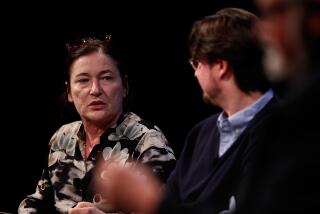Zilpha Keatley Snyder dies at 87; wrote fantastical children’s books
Zilpha Keatley Snyder, the author of dozens of children’s and young-adult novels centered on lonely kids with rich but chilling fantasy lives, has died. She was 87.
Snyder, who lived in a Marin County retirement community, died Oct. 7 in San Francisco of a stroke, according to her publisher, Simon & Schuster.
With more than 40 books to her credit, Snyder won the Newbery Honor – one of the top awards in children’s literature – three times. Her winning novels were “The Headless Cupid,” “The Witches of Worm” and “The Egypt Game” – a 1967 story involving preteens who secretly re-create ancient Egyptian rituals at a makeshift shrine as a child killer lurks in the neighborhood.
For Snyder, it was, like many of her books, drawn from bits and pieces of her own life. As a girl in rural Ventura County, she was entranced with Egypt and, for a time, walked to school each morning as an incarnation of the elegant and mysterious queen Nefertiti.
Conjuring images of gargoyles, witches, sinister cats and harpies whose faces “were those of lovely young maidens except for their wild cruel eyes and the blood that continually smeared their mouths and dripped from their small, sharp teeth,” Snyder frequently was asked where she got her ideas.
“Children ask it poised on tiptoe, ready to run off and get some of their own, and adults (ask it) suspiciously,” she wrote, “as if expecting one to either: 1) Admit to having personally experienced every event described in one’s body of work, or 2) Own up to hereditary insanity.”
In fact, Snyder’s ideas came mostly from the mundane stuff of daily life and an imagination that had been on fire as long as she could remember.
In an autobiographical essay, she recalled frequently rescuing Little Orphan Annie at breakfast.
“Glazed on the bottom of my cereal bowl, Orphan Annie was daily threatened by a sea of milk and gummy oatmeal,” she wrote. “It was necessary for me to eat the disgusting mess quickly to save her from drowning.”
Born May 11, 1927, in Lemoore, Calif., Zilpha Keatley spent her school years in Santa Paula and Ventura, where her father William, a rancher and oil-driller, had been transferred.
In her early teens, she left her country school for a larger one “in the big city of Ventura,” as she wrote, and the pressure drove her even more deeply into reading stories and daydreaming.
“I was suddenly a terrible misfit,” she wrote. “Still wearing long curls and playing secret games, I was too intimidated to make an effort to relate to girls who wore makeup and danced with boys.”
Zilpha’s shyness dissipated in high school and at Whittier College, where she met her husband Larry Snyder, a tall, extroverted piano player. The two married in 1950, lived in Washington state and Alaska during his stint in the Air Force, and finally settled in Berkeley, where for nine years she taught the upper grades of elementary school.
She modeled her characters in “The Egypt Game” on some of her students at Washington School but turned down the book’s transformation into a movie.
“Disney wanted to option it for a film but wouldn’t guarantee a multiracial cast,” her longtime editor Karen Wojytla said in an interview. “She was very forward-thinking, and wouldn’t sell them the rights.”
Snyder also was ahead of her time in giving young readers a chance to figure out intriguing questions of reality and fantasy, said Wojytla, vice president and editorial director at Margaret K. McElderry Books.
In “The Witches of Worm,” the title feline had long, pointed ears “that shifted back on the sides of his head until they formed a horned crescent—like the horns of a devil.”
But did Worm, with eyes that were “diamonds lit by cold, golden fire,” really talk to sad, young Jessica? Did he force her into a string of terrible misdeeds? Was Jessica’s neighbor, the seemingly kind Mrs. Fortune, really a witch?
Snyder provides answers—though sometimes they weren’t obvious to parents offended by her choice of topics.
Witchcraft was a central theme in “The Headless Cupid,” which became No. 98 on the American Library Assn.’s list of the 100 most frequently challenged books of 1990-2000.
During a 1995 discussion about “The Egypt Game,” a dubious school board member in Richardson, Texas, acknowledged that it offered good lessons in the use of similes and metaphors.
“But so does Playboy magazine,” he said. “Do you want your kid reading Playboy magazine?”
Over the years, Snyder wrote about Dust Bowl refugees (“Cat Running”), a teenage boy and a buck deer (“A Fabulous Creature”), a psychic girl in San Francisco (“The Magic Nation Thing”) and young people in a wide array of settings, including the Middle Ages (“Song of the Gargoyle”) and turn-of-the-century Ventura County (“And Condors Danced”).
Her “Green-Sky” trilogy is a fantasy about a world of creatures that live high in the trees and the evil ones that dwell “below the root.” It was made into a video game as well.
In addition to her husband Larry Snyder, a former dean at Sonoma State University, Snyder’s survivors include a son, Douglas, and foster son Benton Lee, a native of Kowloon, China, who came to live with the Snyders when he was 11. A daughter, Susan Melissa Snyder, died in 2005.
Until health issues caught up with her in recent years, Snyder continued to write for young readers, sharing their curiosity, optimism and “lack of reverence for factual limitations.”
The are “peculiarities,” she wrote, “which, like having no front teeth, are perhaps more acceptable in the very young but which, for better or worse, seem to be part of my makeup.”
Twitter: @schawkins
More to Read
Start your day right
Sign up for Essential California for the L.A. Times biggest news, features and recommendations in your inbox six days a week.
You may occasionally receive promotional content from the Los Angeles Times.







